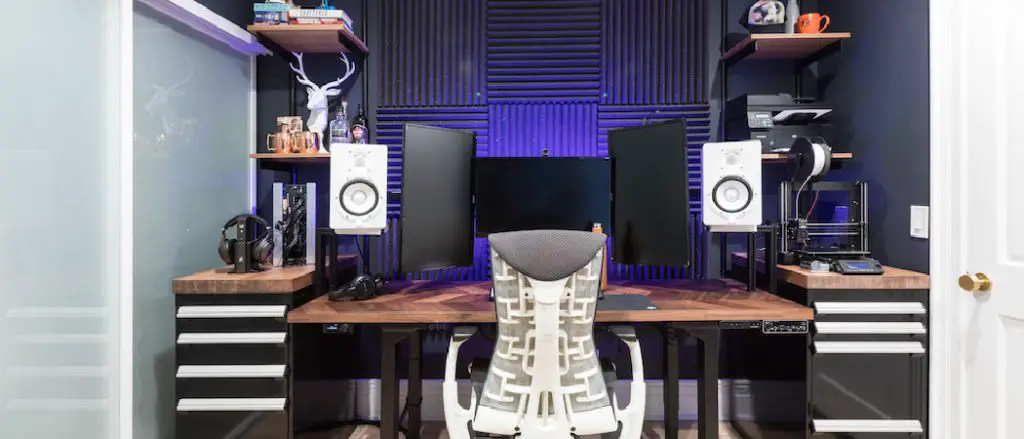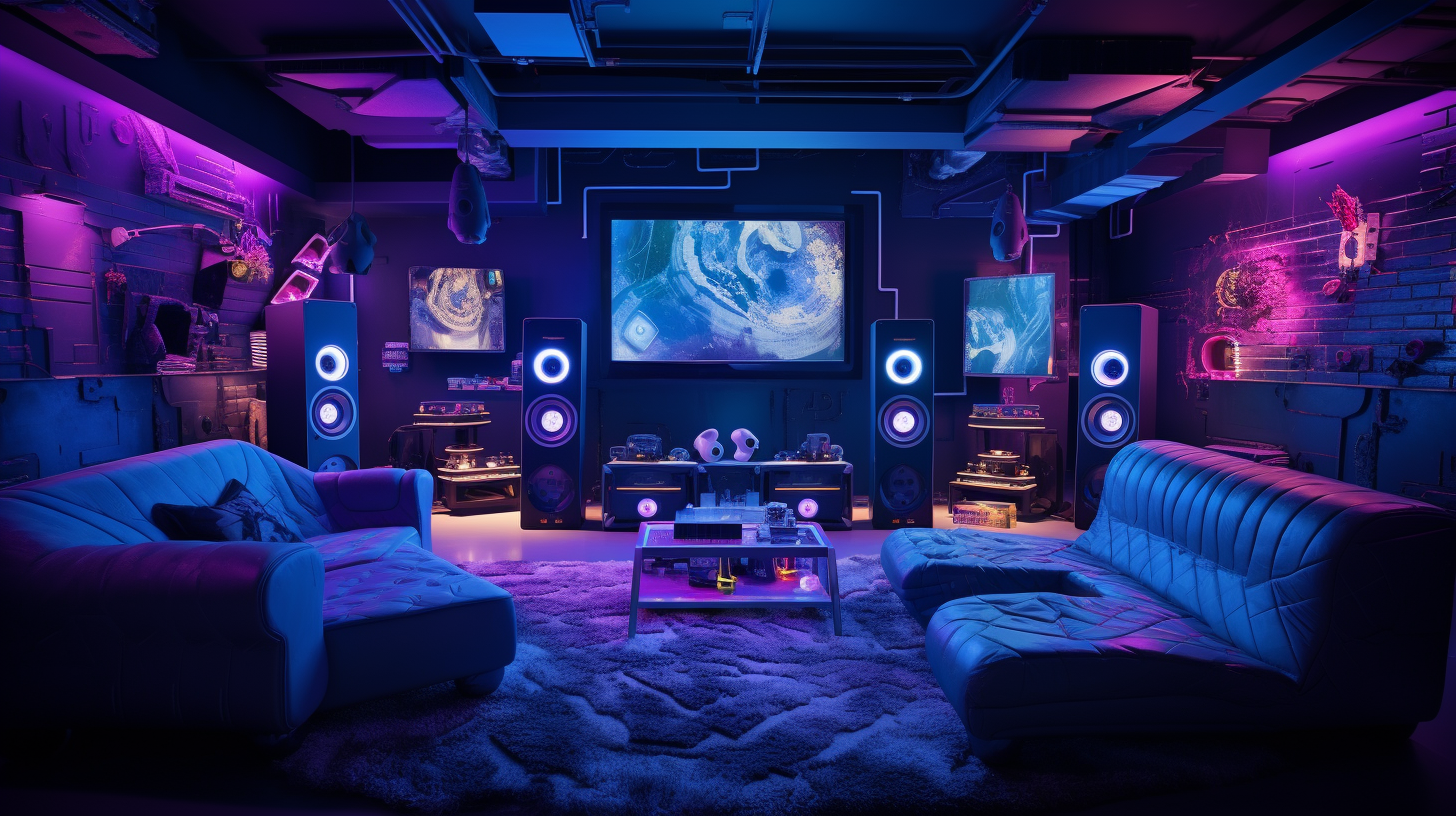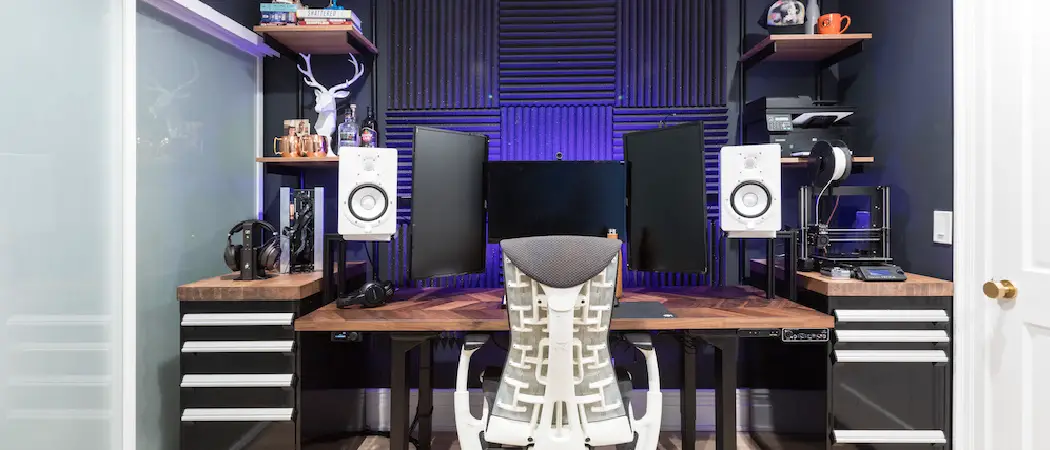To soundproof a room for gaming, use acoustic foam panels and weatherstripping for doors and windows. Create a comfortable and immersive gaming experience by reducing outside noise interruptions.
Soundproofing enhances audio quality and minimizes disturbance, providing an optimal gaming environment. By implementing simple soundproofing techniques, you can elevate your gaming sessions to the next level and fully immerse yourself in the virtual world without external distractions. This guide will explore effective ways Learn how to soundproof a room for gaming with effective tips and materials. Reduce noise, block distractions, and create the ultimate gaming setup for an immersive experience, ensuring that you can focus on your gameplay without any unwanted noise disturbances.

Whether you are a casual gamer or a competitive player, soundproofing your gaming space is essential for an enhanced and uninterrupted gaming experience.
Choosing The Right Location
For effective soundproofing in a gaming room, selecting the right location is crucial. Opt for interior spaces, away from high-traffic areas and external noise sources, to minimize disturbances. Ensuring the room’s structure supports sound-deadening materials will enhance the gaming experience.
When it comes to setting up the perfect gaming room, choosing the right location is paramount. Having a dedicated space for gaming can help you immerse yourself in your favorite games without any distractions. Here are a few key factors to consider when selecting the ideal spot for your gaming sanctuary.
Isolate The Room
Isolating the gaming room is essential to minimize the external noise that can disrupt your immersive gaming experience. Look for a room that is away from busy streets, noisy appliances, or any other potential sources of disturbance. This way, you can create a quiet and peaceful environment where you can truly focus on your games. If possible, choose a room on the top floor or in a secluded area of your home for maximum noise isolation.
Consider Existing Noise Sources
To further enhance the soundproofing capabilities of your gaming room, it’s important to consider any existing noise sources within your home. Take note of the walls, floors, and ceiling materials, as well as the proximity of other rooms or common areas. Thick walls made of sound-absorbing materials like concrete or acoustic panels can significantly reduce noise transfer. Additionally, a room with carpeted floors can help absorb footfall noise, while curtains or blinds can help block out external sounds. Analyzing these aspects will ensure that your gaming room remains a quiet oasis dedicated to your gaming sessions.

Credit: resonics.co.uk
Assessing The Room
Transform your gaming experience by soundproofing your room. Enhance immersion and minimize distractions with these effective tips and techniques.
The process of soundproofing a room for gaming begins with Assessing the Room. To ensure an effective soundproofing strategy, it’s crucial to first identify potential noise entry points within the room.
Identify Noise Entry Points
Begin by locating any gaps, cracks, or openings where sound might escape or enter the room. Focus on windows, doors, vents, and electrical outlets as common areas for sound leakage.
Evaluate Acoustics
Assess the acoustics of the room by considering the type of sound produced during gaming sessions. Analyze the room’s reverberation and echo to determine the level of sound insulation required.
Soundproofing The Walls
When it comes to creating an immersive gaming experience, soundproofing the walls is crucial. By preventing noise from escaping or entering the room, you can enjoy intense gaming sessions without disturbing others or being interrupted by outside sounds. Here are some effective soundproofing methods for walls that will elevate your gaming setup to the next level.
Adding Mass With Soundproofing Panels
If you’re looking to enhance the soundproofing of your gaming room, consider adding mass with soundproofing panels. These specialized panels are designed to absorb and isolate sound, reducing both internal and external noises. You can strategically place these panels on the walls to minimize the transfer of sound waves, enhancing the overall acoustics of the room.
- Effective sound absorption
- Reduction of reverberations
- Improved clarity of in-game audio
Insulate With Soundproof Drywall
Another effective approach to soundproofing your gaming room is to use soundproof drywall. This special type of drywall contains additional layers and materials that significantly reduce sound transmission. By replacing traditional drywall with soundproof variants, you can create a more acoustically sound environment, perfect for immersive gaming experiences.
- Minimized sound leakage
- Enhanced privacy within the room
- Improved concentration during gaming sessions
Soundproofing The Ceiling
Soundproofing the ceiling is crucial for creating an immersive gaming experience. Whether you’re playing action-packed games or enjoying music, a soundproof ceiling can significantly reduce the transmission of noise, creating a quieter and more enjoyable environment for gaming.
Using Acoustic Treatment
Acoustic treatment involves using materials such as acoustic panels and sound-absorbing foam to minimize sound reflections and reverberations in the room. These materials can be strategically placed on the ceiling to dampen airborne noise and prevent it from escaping the gaming space. When properly installed, acoustic treatment can help create a more controlled and balanced sound environment, enhancing the overall gaming experience.
Installing Mass-loaded Vinyl
Another effective method for soundproofing the ceiling is through the use of mass-loaded vinyl (MLV). MLV is a dense, flexible material that can be installed above the ceiling to block airborne noise transmission. By adding a layer of MLV, you can effectively reduce the impact of noise from the floors above, creating a quieter and more isolated gaming area. This can be particularly beneficial in multi-story buildings or apartments where sound transmission between floors is a concern.
Soundproofing The Floor
When it comes to soundproofing a room for gaming, it’s crucial to consider the impact of sound on all surfaces, including the floor. Soundproofing the floor can help minimize noise transmission and create a more immersive gaming experience.
Adding Carpet Or Rugs
One of the most effective ways to soundproof a room’s floor is by adding carpets or rugs. The soft, dense fibers of carpets and rugs help to absorb and reduce impact noise, such as footfalls and moving furniture, as well as airborne noise. Choose thick-pile carpets or rugs for better soundproofing results, and consider placing them strategically in high-traffic areas and around gaming setups.
Using Soundproofing Underlay
Another method for soundproofing the floor is to use soundproofing underlay. This material is specifically designed to reduce impact and airborne noise transmission through floors. Soundproofing underlay can be installed beneath carpets, laminate, or hardwood flooring to minimize sound transfer and improve overall acoustics in the gaming space.

Credit: blog.burtonacoustix.com
Sealing Gaps And Cracks
One of the key steps in soundproofing a room for gaming is to seal any gaps and cracks that may exist. These small openings can allow noise to easily pass through, disrupting your gaming experience and potentially disturbing those around you. Luckily, there are a few simple and effective methods you can employ to seal these gaps and cracks, ensuring a quieter and more immersive gaming environment.
Weatherstripping Doors And Windows
Doors and windows are common areas where gaps and cracks can be found. To prevent sound leaks, it’s important to properly seal these openings. One effective way to achieve this is by using weatherstripping. Weatherstripping involves adding a thin, adhesive strip to the edges of doors and windows to create a tight seal when they are closed. This helps to block out unwanted sounds and prevent drafts as well. When choosing weatherstripping, opt for a durable material such as rubber or foam, as it will provide better insulation and last longer.
Using Acoustic Caulk
An alternative to weatherstripping is using acoustic caulk to seal gaps and cracks. Acoustic caulk is a special type of sealant designed specifically for soundproofing purposes. It is easy to apply and adheres well to different surfaces. Simply fill in any gaps or cracks with the acoustic caulk, making sure to completely seal the openings. This will effectively prevent sound from leaking in or out of the room. Keep in mind that acoustic caulk may take some time to dry, so be patient before testing its effectiveness.
Soundproofing Doors
Soundproofing doors is essential for creating a quiet gaming environment. By following these methods, you can effectively reduce noise transmission through doors.
Installing Solid Core Doors
Replace hollow core doors with solid core doors to improve sound insulation significantly.
Using Door Sweeps
Install door sweeps at the bottom of doors to seal the gap between the door and the floor.
Minimizing Internal Noise
To create an optimal gaming environment, it’s crucial to minimize internal noise inside the room. This can greatly enhance your gaming experience by reducing distractions and improving focus.
Managing Cable Clutter
- Keep cables organized to prevent tangling and interference.
- Use cable management solutions, such as cable clips and ties.
- Keep cables away from high traffic areas to reduce movement noise.
- Consider wireless gaming accessories to further minimize clutter.
Using Quiet Gaming Equipment
- Opt for silent gaming keyboards and mice to reduce typing and clicking sounds.
- Invest in a quiet gaming chair to minimize creaking noises.
- Choose a low-noise CPU cooler and case fans for your gaming PC.
- Consider using noise-canceling headphones to block out external sounds.

Credit: enablingdevices.com
Frequently Asked Questions On How To Soundproof A Room For Gaming
What Is The Best Soundproofing For Gaming?
The best soundproofing for gaming is acoustic foam panels. They absorb sound waves, reducing echo and noise. They are easy to install and come in various sizes and shapes. With acoustic foam panels, you can create a quieter gaming environment for better concentration and immersion.
How Do You Soundproof A Room So Others Can’t Hear?
To soundproof a room, use soundproof curtains, acoustic panels, weatherstripping, carpets, and door sweeps. Also, add bookshelves or plants for added noise absorption.
How Do You Soundproof A Room Asap?
To soundproof a room ASAP, follow these steps: 1. Seal gaps and cracks with weather stripping and caulk. 2. Add thick curtains or drapes to absorb sound. 3. Place rugs or carpet to reduce noise reflections. 4. Use acoustic foam panels on walls.
5. Install a door sweep or door sweep for sound insulation.
Where Do You Put Acoustic Panels In A Gaming Room?
Place acoustic panels in a gaming room on the walls behind the main listening area to reduce echoes and improve sound quality. Focus on areas with parallel walls to minimize sound reflections and enhance the gaming experience. Positioning panels strategically can help create a balanced and immersive sound environment.
Conclusion
Incorporating soundproofing materials can greatly enhance your gaming experience. By implementing these practical tips, you can create an immersive gaming environment without disturbing others. Remember, a well-soundproofed room not only enhances audio quality but also your overall gaming enjoyment. Start soundproofing and level up your gaming space now.

